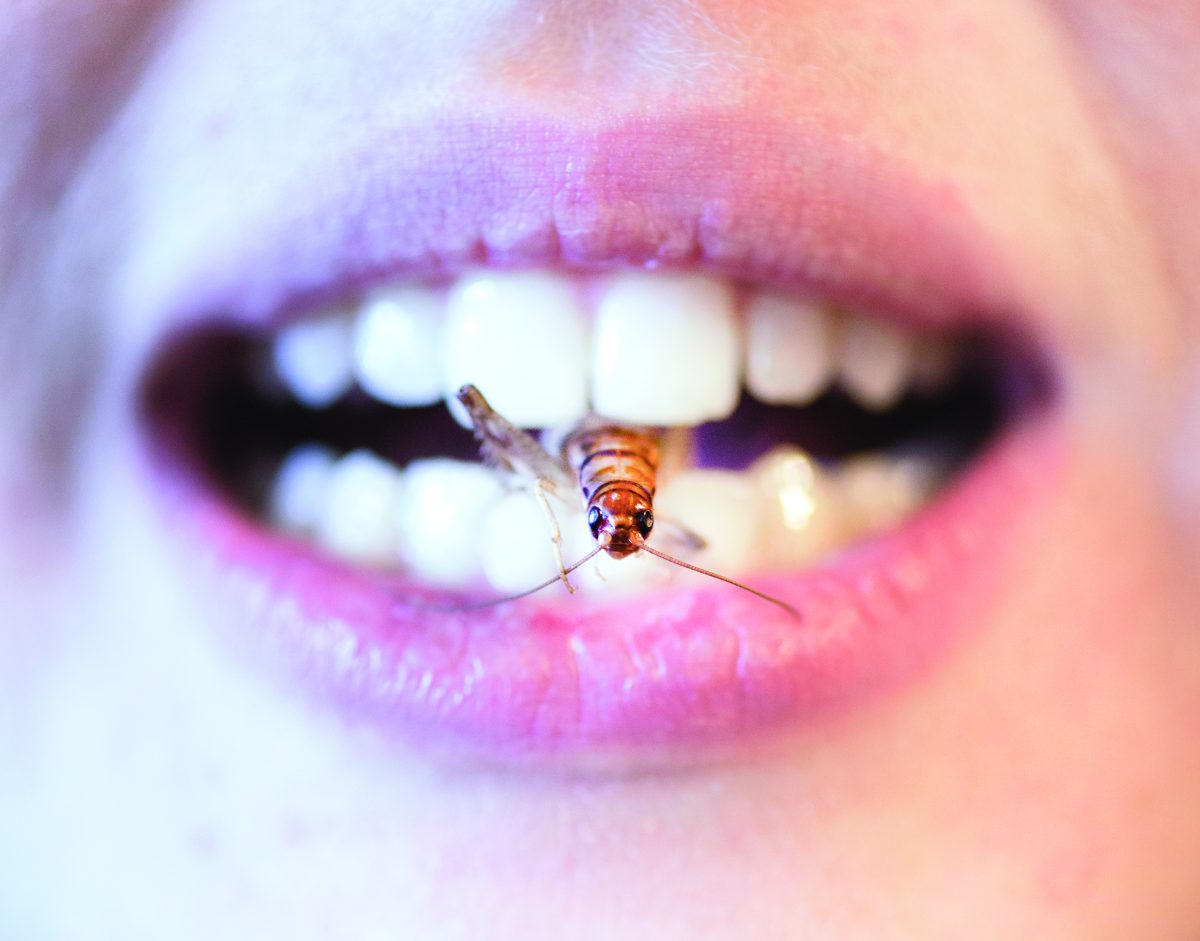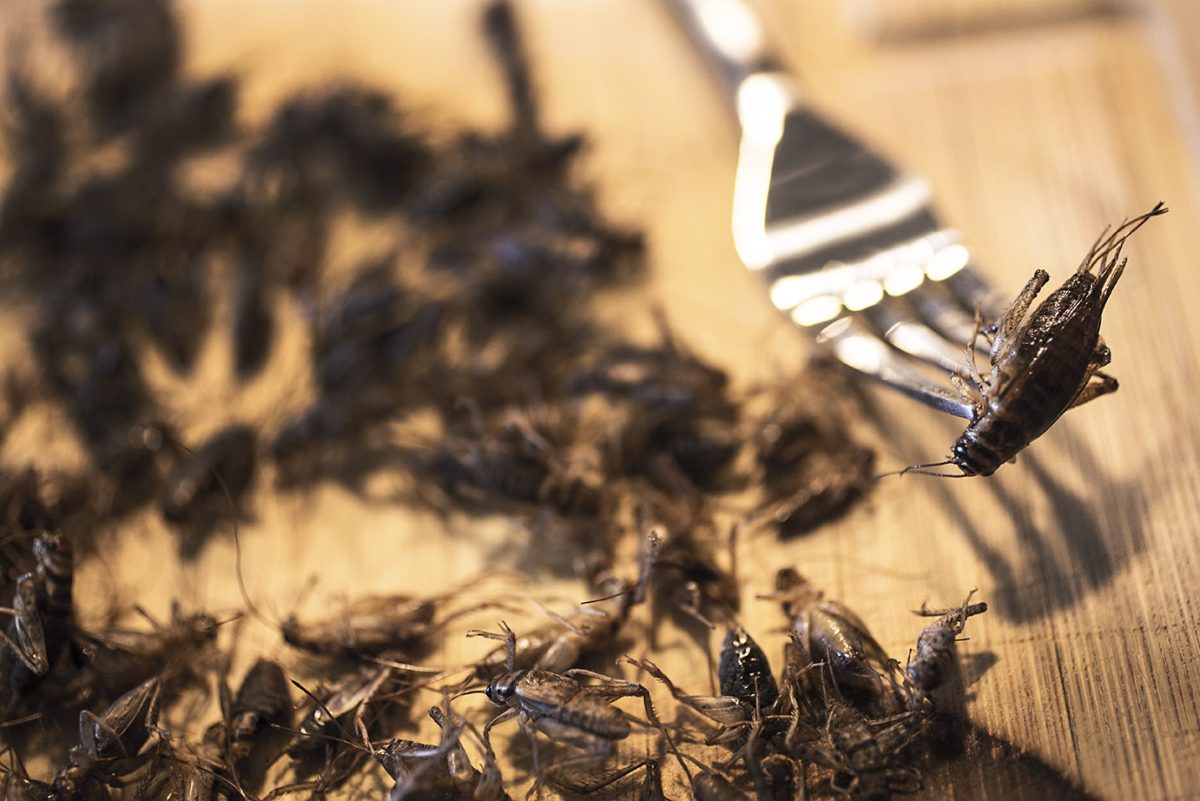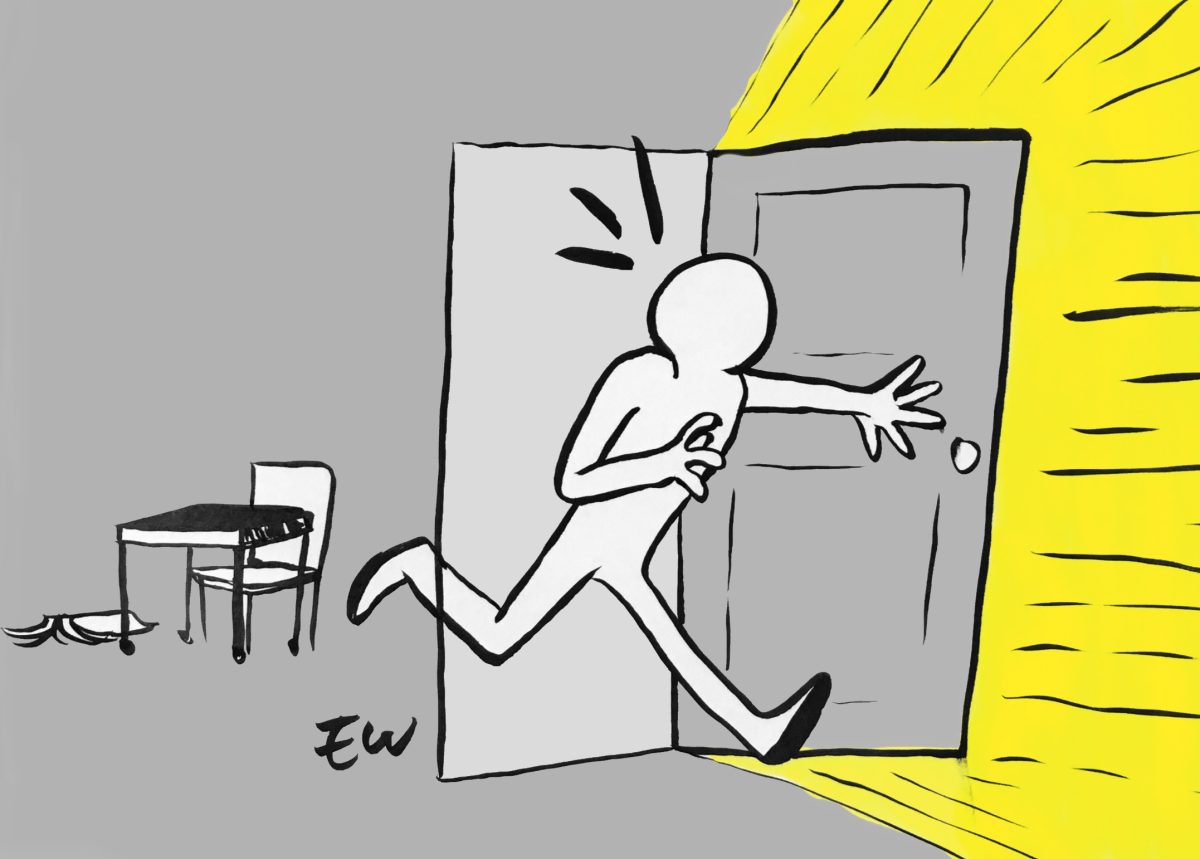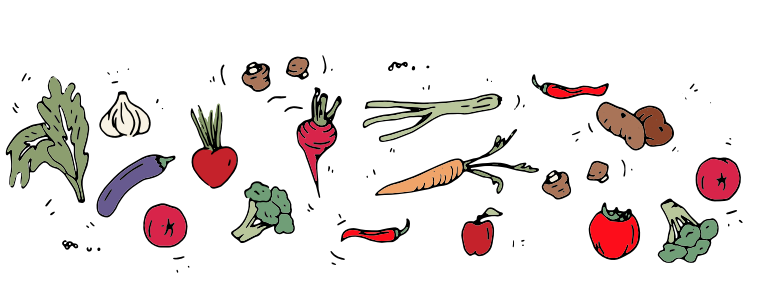Insects may be the food of the future.
He stared back at me with black faceted eyes. It must have been an imperceptible breeze, a trick of the light, but I could have sworn I saw his delicate feelers and jumping-jack limbs move, just a bit. The little bugger had been shipped, starved, frozen, boiled, roasted and fried. Why did he still seem decidedly undead?
Reader, I munched him. I bit down on the brittle body of a whole cricket. My mantra, “mind over mouthfeel,” was harder to hold fast to than I had previously thought. I knew in my mind that I was eating the sustainable superfood of the future, according to a report by the Food and Agriculture Organization of the United Nations. But the crunch in my mouth as exoskeleton gave way to waxy insect guts was enough to make me gag. Even after I forced myself to swallow, tickly cricket legs remained stuck between my teeth.
The benefits of entomophagy, or bug eating, are manifold. The UN sees edible insects as a promising solution to world hunger, global warming, and pollution. They’re a cheap, efficient, accessible, and nutritious source of food, and eating them is a healthy choice for both humans and the environment.
Using these micro-livestock as a food source is an environmentally friendly alternative to raising cows, chickens and sheep because insects emit lower levels of greenhouse gases. Compared to farming traditional livestock, rearing insects requires less input for the same output: they efficiently convert their feed into bodyweight, and they don’t need a lot of land to live on. Crickets contain about the same amount of protein per gram as beef, and mealworms are comparable to fish in their levels of omega-3 fatty acids. Besides protein and healthy fats, edible insects provide essential vitamins, minerals, and fiber.
Around a third of the world’s population already eats insects and incorporates them into their traditional cuisines. Approximately 1900 species of bugs are consumed worldwide. Though insects are the cousins of shellfish like shrimp and prawns, Westerners remain averse to the idea of dining on them. And I am among the guilty.
“Insects are yucky, dirty. You get trained into believing this as a child,” explains Sujaya Rao, professor of entomology at Oregon State University. She says reactions like mine are all in my mind.
Rao supports and partakes in entomophagy even though she’s a vegetarian. But not all who avoid eating animals agree. In 2012, some vegans and vegetarians protested when they found out that Starbucks’ strawberry Frappuccino contained cochineal, a red food coloring component sourced from crushed beetles. In response to the pressure, Starbucks transitioned to a plant-derived dye.
Even so, a cup of coffee — with or without the beetle juice — provides a protein-packed daily dose of bugs, as up to ten percent of coffee beans can be insect infested. Like it or not, we all regularly consume creepy crawlies. The FDA readily approves foods containing up to a certain amount of bug parts. These “defects,” as the FDA so diplomatically calls them, are purely aesthetic and carry no health risk. Rao’s advice: “Stop worrying about insects in your food. You can’t avoid every single one, and it means you have no insecticide.” Organic food, that holy grail of healthy eating, is roach-ridden as well as pesticide-free.
In 40 to 50 years, insect eating may become mainstream, says Rao, especially if we start feeding bugs to the next generation while they’re kids. For now, edible insects are something of a novelty in Western culture. Is it novelty that compels me to order 200 crickets and 500 mealworms from Southern California based Rainbow Mealworms? Their insects, raised on all-organic, non-GMO feed, are intended for the distinguished reptilian and avian palates, and are safe for human consumption. I choose my specimens by age and size: the crickets are five weeks old, and the mealworms half an inch. They are shipped live. I will have the privilege of butchering the bugs myself.
I’m a happy carnivore with no ethical concerns about edible insects. From seafood to snails to still-mooing steak, I regularly enjoy meals that have recently left the land of the living. But for some reason, the sound of my crickets chirping on the kitchen counter makes me shudder. The mealworms crawl across their newspaper habitat with a crackling sound. Professor Rao tells me I can eat the mealworms alive and still squirming, but that is more adventurous than I am willing to attempt.
There are many ways to skin a cricket. I choose them all. I barely open the box before popping them straight into the freezer. After an hour or so in cold temperatures, they will enter a state of stasis, in which they’re technically alive but unmoving. Just to be sure, I leave them in there for a few days. The night before the feast, I boil them clean. Bubbling away on the stove, the bugs give off a pungent aroma, something between earth and excrement. Then, I dry roast them, determined to avoid, in the words of The Lion King, anything “slimy yet satisfying.”
I plan an amateur’s arthropod dinner menu, trying to pick out dishes that will trick me into taking a bite. The charmingly named chocolate “chirp” cookies will be my first foray into the world of insects as food. I stir ground up crickets and mealworms into the batter, along with a sprinkle of cinnamon to distract from the insect specks. My taste buds fail to detect any significant difference. Later, my all-too-trusting brother Alex will be two bites into the cookie and completely unaware of its secret ingredient, before he looks at me, eyes narrowed with suspicion. My evil laugh may have given me away.
I make mealworm fried rice, and I don’t mind it so much. Looking down at a bowl of maggots could take some getting used to, yes, but if I close my eyes I can take a bite. The mealworms add a pleasant crunch to the dish, and I can easily convince myself that they’re extra crispy grains of rice. If they have their own flavor, it blends into the colorful backdrop of soy and ginger, green onion and egg.
The final dish is a cricket taco; I’ve saved the most difficult for last. Perched on leaves of lettuce and sprigs of cilantro, the crickets look like they could be crawling around. It’s a rich flavor, too intense to be easily masked in a sauté of garlic and lime. I taste savory fat and a robust meatiness — but it’s a far cry from bacon or chicken or nuts or anything I’ve ever tasted, contrary to what some entomophagists have compared it to. Cricket tastes like one thing: cricket. I’m not a picky eater, but these are something else. Nutritious they may be, but delicious they are not.
Of the three courses, two were tolerably tasty, one was just not for me. Perhaps it was psychological, but I wasn’t lining up for second helpings — or even second bites. When it comes to eating creepy crawlies, I will remain cautiously curious.
(Emily Albertson/Ethos)













![Before dinner, Paige gives James his medicine in the form of a cannabis oil filled capsule. James takes about 45mg of CBD and THC/THCA oil throughout the day. The CBD helps reduce his seizures while the THC and THCA helps regulate his emotions and impulse control. “He is more able […]](https://ethos.dailyemerald.com/wp-content/uploads/2018/01/d78a0fd1da4fdc3992cdea4aebdc20db-1200x800.jpg)





